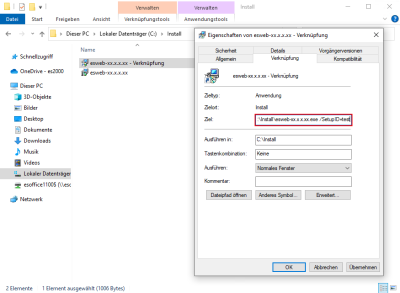es2000 does not make any recommendation regarding the suitability of the following information. Errors and exceptions are excluded and no responsibility is accepted for the information provided. The statements are simply descriptions and do not guarantee the consistency of the products. The information may also in part be regarded as an attempt to provide you with assistance for a task even if the product was not actually intended for this special purpose.
How is it possible to use several esweb instances in parallel on a web server, for example for a productive system and a test system, without having to provide separate hardware or separate virtual machines for each instance?
Solution
You can install several named esweb instances in parallel using Setup. Installation for this application case only is always performed with an additional parameter:
esweb-xx.x.x.xx.exe /SetupID=<name>
This additional parameter can be added to the esweb installation program (Setup) using the properties of a link (shortcut).
esweb-xx.x.x.xx.exe /SetupID=test
This additional parameter can be added to the esweb installation program (Setup) using the properties of a link (shortcut).
The following describes one way to create a program shortcut and add a parameter.
Create and edit program shortcut
-
Copy the esweb installation program esweb-xx.x.x.xx.exe into a directory, for example the INSTALL folder.
xx.x.xx.xx = Installation program version number
-
Open Windows Explorer and open the newly crated folder.
-
Right click on the esweb-xx.x.x.xx.exe program file.
-
Select the Copy command in the context menu.
-
Right click on a free space in the directory and select the Insert link command in the context menu.
-
Right click on the link you inserted and select Properties in the context menu.
Links are indicated by the arrow icon
 .
. -
You can use the following parameters in the target or command line. If you use more than one parameter they must be separated by a space.
The associated instance and the folder are then named as follows:
esweb instance
esweb<name>
Directory name on IIS web server
C:\inetpub\wwwroot\ESWeb<test>
/SetupID=test
eswebtest
C:\inetpub\wwwroot\ESWebtest
In this way, the separate differently named instances can also be updated (Update).
Make sure that you specify the correct instance name in the SetupID when executing an Update if you are using several instances to avoid overwriting a productive instance by entering the wrong name, for example.
You can find information about installing and setting up esweb under esweb installation.
